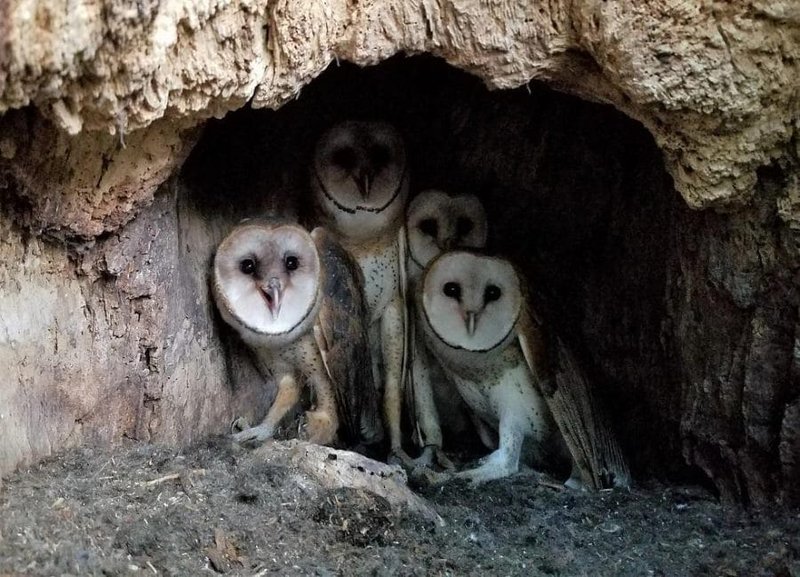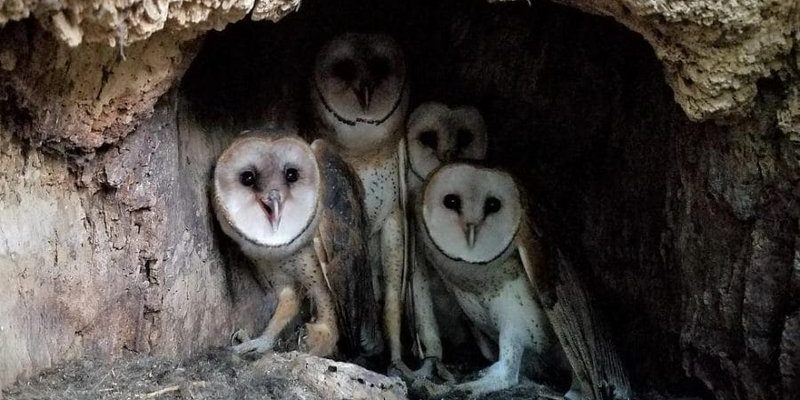
You might be wondering how barn owls find their nesting spots or how they care for their chicks. Honestly, understanding their breeding behaviors and lifecycle can shed light on why these owls thrive in various environments. So, grab a cup of coffee, and let’s explore the fascinating journey of barn owls from nesting to raising their young.
Where Do Barn Owls Nest?
Barn owls are quite adaptable when it comes to their nesting locations. They often choose places where they can find shelter and safety from predators. You’ll find them in old barns, abandoned buildings, or even in tree cavities. They might also use nest boxes set up by humans, which can be a great way to encourage barn owls into your area.
Here’s the thing: barn owls prefer high, dark places, which help them feel secure. These locations provide protection from harsh weather and give them a good vantage point to keep an eye out for potential threats. Plus, nesting in these spots means fewer disturbances, making it easier for them to focus on raising their young.
You might be surprised to know that barn owls can also be quite the opportunists. If the perfect site isn’t available, they can adapt to nesting in places you wouldn’t expect—like on ledges or in large shrubs! It’s a testament to their resilience and ability to thrive in varied environments.
The Nesting Process
Once they’ve found a suitable place, the courtship begins. Barn owls typically mate for life, so this isn’t just a fleeting romance. Their courtship rituals often involve intricate displays, including mutual preening and a series of soft hoots. It’s all part of the bonding process that strengthens their partnership.
Once they’re ready to start a family, the female lays between 2 to 18 eggs, depending on factors like food availability and season. The eggs are usually laid a few days apart, and they have a smooth, white appearance. The female takes on most of the incubation duties, which lasts about 30 to 34 days. During this time, the male works hard to provide food for her and their future chicks.
You can almost picture the scene: the male swooping out at dusk, hunting for small mammals, and returning to the nest with a mouse or rat clutched in his talons. It’s this teamwork that sets the foundation for a healthy brood of owlets.
The Lifecycle of Barn Owls
After the eggs hatch, the real adventure begins. Barn owl chicks, or owlets, emerge covered in soft down feathers, looking quite helpless at first. They rely entirely on their parents for warmth and food. For the first few weeks, they’re quite dependent on their mother, who regurgitates food for them—a little gross, but it’s how they get the nutrients they need to grow.
As the owlets mature, they’ll begin to develop their feathers and grow stronger. Within about 6 weeks, they’re ready to leave the nest and explore their surroundings. You might be surprised by how quickly they become independent. They often stick close to the nest during this stage, practicing their flying skills and learning how to hunt.
The transition to independence is crucial. It helps them build strength and confidence, preparing them for life beyond the safety of their parents. It’s a bittersweet moment, witnessing the young owls take their first flights—like watching your kids leave home for the first time.
Feeding Habits of Barn Owls
Feeding is a critical aspect of the barn owl lifecycle, impacting their nesting success and the health of their chicks. Barn owls are primarily nocturnal hunters, using their excellent hearing and night vision to locate prey. They primarily dine on small mammals like mice, voles, and shrews. In fact, a single barn owl can consume more than 1,000 rodents in a year!
Here’s where it gets interesting: barn owls have a unique hunting style. They fly silently through the night, thanks to specialized feathers that reduce noise, allowing them to sneak up on unsuspecting prey. Once they spot a target, they swoop down with astonishing precision. This hunting skill is essential for feeding both themselves and their chicks during the critical early weeks.
In addition to small mammals, barn owls will also eat birds and insects if the opportunity arises. Their adaptable diet helps them thrive in various environments, making them resilient hunters. This resourcefulness is part of what makes their lifecycle so fascinating; they’re always adjusting and finding ways to survive.
Challenges and Threats to Nesting Success
While barn owls are remarkable creatures, they face a range of challenges that can impact their nesting success. Habitat loss is one of the biggest threats. As farms and rural areas develop, natural nesting sites like old barns and trees diminish. This reduces their options for safe nesting places, making it harder for them to raise young.
Additionally, exposure to pesticides can harm barn owls. These chemicals can reduce their food sources, leading to malnutrition. When owls consume poisoned prey, it can have fatal consequences. Environmental changes, such as climate change, also disrupt their habitats, affecting available prey and nesting conditions.
Despite these challenges, conservation efforts are underway. Nest box programs and habitat restoration projects are helping create safe spaces for barn owls. It’s heartening to see people work together to protect these beautiful birds and ensure their survival for future generations.
The Importance of Barn Owls in the Ecosystem
You might be wondering why barn owls matter at all. Well, they play a crucial role in controlling rodent populations. By keeping these populations in check, barn owls help maintain balance in the ecosystem. Fewer rodents mean less crop damage for farmers, making them valuable allies in agricultural settings.
Their presence is also an indicator of a healthy environment. When barn owls thrive, it often means that the ecosystem is in good shape. It’s like having nature’s own pest control team working around the clock, keeping everything in balance.
Supporting barn owls isn’t just about appreciating their beauty; it’s about recognizing their vital role in the web of life. Protecting their habitats and ensuring they have enough food contributes to a healthier ecosystem for all of us.
The journey of barn owls from nesting to raising their young is a beautiful, intricate tale of survival. These birds navigate challenges, adapt to their environments, and create strong family bonds. Understanding their nesting habits and lifecycle not only highlights their resilience but also fosters a greater appreciation for the natural world.
As we learn more about barn owls, we can take steps to protect them and their habitats, ensuring that these enchanting creatures continue to soar through our skies. So next time you see a barn owl gliding silently at dusk, remember the remarkable journey it has taken to get there—one filled with trials, teamwork, and the beauty of nature.

